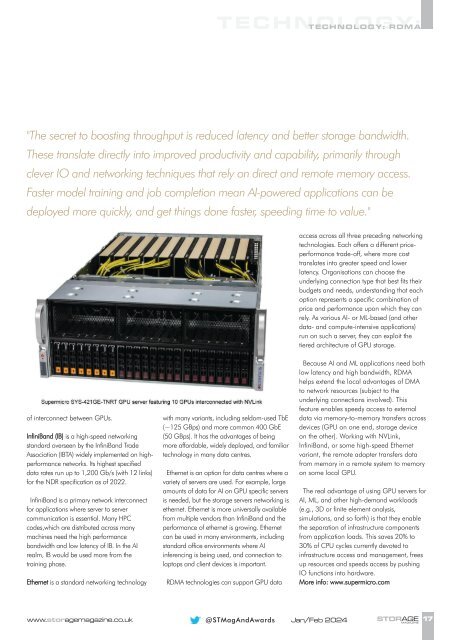ST2401
You also want an ePaper? Increase the reach of your titles
YUMPU automatically turns print PDFs into web optimized ePapers that Google loves.
TECHNOLOGY: RDMA<br />
"The secret to boosting throughput is reduced latency and better storage bandwidth.<br />
These translate directly into improved productivity and capability, primarily through<br />
clever IO and networking techniques that rely on direct and remote memory access.<br />
Faster model training and job completion mean AI-powered applications can be<br />
deployed more quickly, and get things done faster, speeding time to value."<br />
access across all three preceding networking<br />
technologies. Each offers a different priceperformance<br />
trade-off, where more cost<br />
translates into greater speed and lower<br />
latency. Organisations can choose the<br />
underlying connection type that best fits their<br />
budgets and needs, understanding that each<br />
option represents a specific combination of<br />
price and performance upon which they can<br />
rely. As various AI- or ML-based (and other<br />
data- and compute-intensive applications)<br />
run on such a server, they can exploit the<br />
tiered architecture of GPU storage.<br />
of interconnect between GPUs.<br />
InfiniBand (IB) is a high-speed networking<br />
standard overseen by the InfiniBand Trade<br />
Association (IBTA) widely implemented on highperformance<br />
networks. Its highest specified<br />
data rates run up to 1,200 Gb/s (with 12 links)<br />
for the NDR specification as of 2022.<br />
InfiniBand is a primary network interconnect<br />
for applications where server to server<br />
communication is essential. Many HPC<br />
codes,which are distributed across many<br />
machines need the high performance<br />
bandwidth and low latency of IB. In the AI<br />
realm, IB would be used more from the<br />
training phase.<br />
Ethernet is a standard networking technology<br />
with many variants, including seldom-used TbE<br />
(~125 GBps) and more common 400 GbE<br />
(50 GBps). It has the advantages of being<br />
more affordable, widely deployed, and familiar<br />
technology in many data centres.<br />
Ethernet is an option for data centres where a<br />
variety of servers are used. For example, large<br />
amounts of data for AI on GPU specific servers<br />
is needed, but the storage servers networking is<br />
ethernet. Ethernet is more universally available<br />
from multiple vendors than InfiniBand and the<br />
performance of ethernet is growing. Ethernet<br />
can be used in many environments, including<br />
standard office environments where AI<br />
inferencing is being used, and connection to<br />
laptops and client devices is important.<br />
RDMA technologies can support GPU data<br />
Because AI and ML applications need both<br />
low latency and high bandwidth, RDMA<br />
helps extend the local advantages of DMA<br />
to network resources (subject to the<br />
underlying connections involved). This<br />
feature enables speedy access to external<br />
data via memory-to-memory transfers across<br />
devices (GPU on one end, storage device<br />
on the other). Working with NVLink,<br />
InfiniBand, or some high-speed Ethernet<br />
variant, the remote adapter transfers data<br />
from memory in a remote system to memory<br />
on some local GPU.<br />
The real advantage of using GPU servers for<br />
AI, ML, and other high-demand workloads<br />
(e.g., 3D or finite element analysis,<br />
simulations, and so forth) is that they enable<br />
the separation of infrastructure components<br />
from application loads. This saves 20% to<br />
30% of CPU cycles currently devoted to<br />
infrastructure access and management, frees<br />
up resources and speeds access by pushing<br />
IO functions into hardware.<br />
More info: www.supermicro.com<br />
www.storagemagazine.co.uk<br />
@STMagAndAwards Jan/Feb 2024<br />
STORAGE<br />
MAGAZINE<br />
17
















